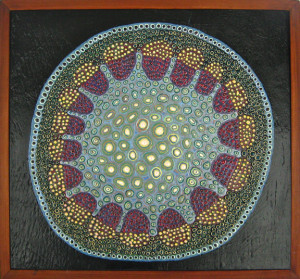Bridget May
First Time Art Party Participant
Aristolochia
Artist’s Website
www.bridgetmay.com
Artist’s Statement
Bridget May was born in San Jose, CA and studied Art and Botany at San Francisco State University. She would have studied biology but she wanted to avoid cutting up animals if possible. She is currently living and working in San Francisco.
A little bit about plant anatomy:
“The primary vascular systems of mono- and dicotyledons generally differ considerably. In a transverse section of the monocotyledonous stem, [such as Bamboo] there are many scattered vascular bundles, while in dicotyledons a smaller number of bundles are usually arranged in a cylinder outside a wide pith. The roots of monocotyledons frequently show a central pith with a large number of strands of alternating xylem and phloem on the periphery. But in the dicotyledons a star shaped core of xylem commonly occurs with strands of phloem lying between its several arms.”
—Bryan G. Bowes, A Color Atlas of Plant Structure
The study of plant anatomy is a science but it sincerely looks like art. The first time I looked at a plant stem cross section under a microscope was a revelation to me. The tissues, stained with various compounds that help to differentiate the systems of the plant, present an exquisitely colored quilt of cells which cause the mind to race, imagining what other treasures exist unseen all around us. My own skin, perhaps, or my own eye if magnified, might reveal a pattern of cells that echo the architecture of a far off constellation or the tessellation of the houndstooth jacket hanging on the back of my chair.
From these magnified images I extrapolate more and more intricate and subtle layers of color. Color context and harmony are elements that I experiment with as I expand upon the patterns in nature. The relativity of color —be it through hue, value, saturation, or temperature, and the use of tints, tones and shades—can make the choice of one color over another the minute difference between a painting that works and one that does not. This often intuitive decision making unearths things that add real value to the final product.



